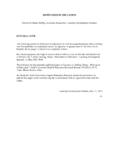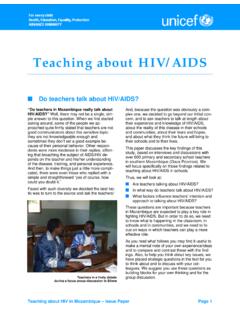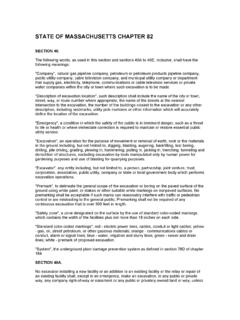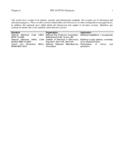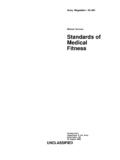Transcription of CHAPTER 2: LITERATURE REVIEW
1 11 CHAPTER 2: LITERATURE REVIEW In the two decades since HIV/AIDS was first identified, the body of research into the disease has been steadily growing. Today this research covers a wide range of topics ranging from strictly medical studies to the social and demographic implications of the study as well as to research into interventions and best practices that may help to halt the spread of the disease. This CHAPTER will provide an overview of the impact of HIV and AIDS in Africa, discuss various strategies that have been used to address HIV/AIDS, reviews assumptions and key findings with regard to using teachers as tools for change, provides an overview of variables that have been associated with HIV/AIDS behavior, and briefly reviews two key theories that are used as the basis for this study (namely the Theory of Planned Behavior and Attitude Functions).
2 The CHAPTER concludes with a description of the research questions and hypotheses for this study. The Impact of HIV/AIDS in Africa The statistics about the impact of HIV/AIDS world-wide are overwhelming. Estimates of the United Nations Agency for AIDS (UNAIDS) indicate that over 40 million people were living with HIV/AIDS in 2001, that nearly 25 million people have died of AIDS since the disease was first discovered in the early 1980 s, and that more than million children under 15, have lost either their mother, their father, or both parents as a direct result of AIDS (UNAIDS, 2001).
3 While every nation has in some way been affected by this pandemic, it is in Africa that the grip of HIV and AIDS has been, by far, the deadliest. Twenty-eight million people in Africa are living with HIV/AIDS and Southern Africa has the highest HIV adult prevalence in the world. Well over two thirds of the HIV/AIDS related deaths (18 million, or 72%) are from Africa (World Bank, 2002) and almost one in every ten adults in sub-Saharan Africa are HIV positive (UNESCO, 2002), although infection rates in individual countries such as South Africa, Botswana, Malawi, and Swaziland are much higher.
4 The magnitude of the problem becomes clear when one considers that well over one third (39 percent) of adults in Botswana, and one in every five (20 percent) adults in South Africa, are estimated to be HIV positive (NIC, 2002). At a human level, the financial burden of HIV/AIDS is at least 30% greater than deaths from other causes, because it affects the most productive age group (young adults), and because the costs of medication and caring for the sick are staggering and can be prolonged (Coombe, 122002). HIV/AIDS leads to financial, resource and income impoverishment (Barnett & Whiteside, 2002), and puts severe strain on individuals and households.
5 The psychological stress that is a direct consequence of the impact of HIV/AIDS on individuals and families can compromise school and work performance, family relationships, and the capacity to take care of children, and may also culminate in risk behavior such as alcohol and drug abuse and in unsafe sexual behavior (Coombe 2002). The HIV/AIDS pandemic disproportionately affects women who already carry a very hard burden in many African countries. From a physiological and medical perspective women are at a greater risk of getting infected. In addition, they are often solely responsible for the household and the children, and have less financial and material reserves to fall back on.
6 Women also face the risk of abandonment or abuse at the hands of their partners when HIV/AIDS strikes. And when family members fall sick as a result of HIV, it is most often the girls who will be removed from schools to take care of those who are sick (Barnett & Whiteside, 2002). This increases their susceptibility to poverty and to the disease because they will probably marry younger and will not have the benefits of an education. HIV/AIDS represents not only a tragedy at a human level but also heavily affects the economic development of countries, many of which are already severely strained for resources.
7 The weight on the health system is tremendous and the loss of productive workforce has implications for the economy. Cross country analyses conducted by the World Bank suggest that the region of Southern Africa is losing an estimated to percent per capita growth per year as a direct result of HIV and AIDS and that by the year 2010 it may have reduced the aggregate output by between 15 to 20 percent (World Bank, 2002). By some estimates between 50 and 80 percent of hospital beds in Southern Africa are occupied by people with HIV related infections (UNAIDS Press Release, 2001).
8 UNAIDS (2003) warns that unless drastic action is taken, the damage that has already taken place is very likely to be minor compared to what is still to come. In fact, as Kelly (2003) notes, all predictions to date have proven to be conservative at best with dire projections about the progression of the pandemic needing to be revised every year because they are inevitably short of the mark. Changing Strategies in Addressing HIV/AIDS In Africa, HIV/AIDS has - since it was first discovered - been a predominantly heterosexually transmitted disease which affects men, women and children, although in varying proportions.
9 Because the pandemic poses such enormous challenges, governments and health 13planners have been hard pressed to find adequate ways of containing its spread and the last two decades have seen a multiplicity of different approaches develop, some which have since been discarded. In Africa, as in other continents, HIV/AIDS was initially seen mainly as a health concern, and it was widely assumed that preventive and supportive interventions which directly targeted vulnerable segments of the population (truck drivers, sex workers, drug users, etc.) would succeed in containing the pandemic.
10 However, as the dimension of the problem started to become increasingly evident, the woeful inadequacy of this approach became apparent and the disease quickly spread over to other segments of the population (World Bank, 2002). Over the past five to seven years the focus has shifted from approaches targeted very specifically to segments of the population from a health perspective to multi-sectoral plans and strategies, which seek to involve a wide variety of government and non-governmental agencies (Coombe, 2002). The rationale for a multi-sectoral approach arises from the recognition that HIV/AIDS requires an integrated response to break the cycle of poverty and gender inequality that is at the center of its spread (UNESCO, 2002).


